Jump Higher with Cody Kessel
This article was written by Cody Kessel
I get asked by younger players if there are any special weight training programs I can recommend so that they can get their verticals up—fast!
Of course I cringe a bit when I hear that question, because if I give you a program to “quickly add inches to your vert”—you will likely destroy your knees for a short-lived gain in your vertical jump test numbers—for what? It also would not necessarily translate to your long-term health as an athlete, or actually playing volleyball.
As with most things, you get out what you put in, and there’s no short-term hack to having a great leap.
But I can give you guidance on how to become a more dynamic and resilient jumping athlete, so that you can play the sport for longer, with more joy and less pain, and thereby maximize your potential.
So below is a lot of my experience and my longer answer to the more general question of “How can I jump higher?”
Athletic Foundation and Late Specialization
When I was a kid I liked jumping and I jumped a lot. I enjoyed seeing how high I could jump, how often.
Here’s a photo of me scoring a goal by jumping across the crease in lacrosse— something I really don’t recommend —because you usually get absolutely CRUSHED by a defender or goalie body check after or before you shoot this kind of a shot. It’s the equivalent of running a crossing route in football in the middle of the field right into the safety….
Anyway—I was super active as a kid growing up in Colorado Springs. I played soccer, football, basketball, handball, tennis, ultimate frisbee, judo, lacrosse, and was also a swimmer and skier. I started playing competitive volleyball when I was 12 with my dad in the Father/Son, Father/Daughter grass volleyball tournament held in Vail, Colorado over Father’s Day Weekend. My dad and I won ski lift tickets by winning our division those next few years, and I was hooked.
I played 8 years of lacrosse from ages 9-17, my other main sport, but I would always play some kind of grass or sand doubles volleyball in the summer.
In general, research in the area of long-term-athlete-development (LTAD) shows many positives that come from playing many sports when you are younger. If you do, you will likely have an athletic career with less injuries, and you are less likely to experience burnout.
This is especially applicable in a sport like volleyball where athletes often compete at their peaks in their late 20s and early 30s.
In 2008 our USA Men’s Gold Medal Volleyball Team had an average age of 31.
In 2012 the average age was 28 across all Olympic Men’s Indoor volleyball players
The average age for our USA Men’s Indoor Team this past year in Tokyo was 29.9.
Our 2021 Men’s Olympic Beach Team included Jake Gibb (45) Phil Dalhausser (41) and Nick Lucena (41)!!!
Hopefully these numbers get you to take a bit longer view in regards to your development as a volleyball player.
The foundation for my athleticism came from playing all these sports, and then I was able to upgrade it later in the weight room, which I was first exposed to at 16 at my local YMCA. I didn’t fully specialize in volleyball until I was 17. Even then, I played a mix of indoor in the winter and spring, and beach/grass in the summer.
Especially as a blocker in doubles, I would often block and try to MAX JUMP (against a real hitter in a game-like way with the right timing) whenever I could. We get good at what we spend our time doing. I spent multiple summers jumping on grass or in sand A LOT.
 Much shorter and skinnier me at 17 getting in a couple game-like reps!
Much shorter and skinnier me at 17 getting in a couple game-like reps!
My Uncle Damone (pictured below with me at a CBVA tournament in Santa Monica) – first handed me a P90X yoga DVD when I was 18. A Division I football athlete himself, he said “This will help make you a beast!” Following that program in my living room for the first time was a big wake-up call to an area that many neglect: flexibility, pliability, and strength with length. I’m so grateful he handed me that DVD when he did. I think it saved me a lot of future pain points as I began to increase my range of motion and first connect more deeply with my breath and body mindfully.
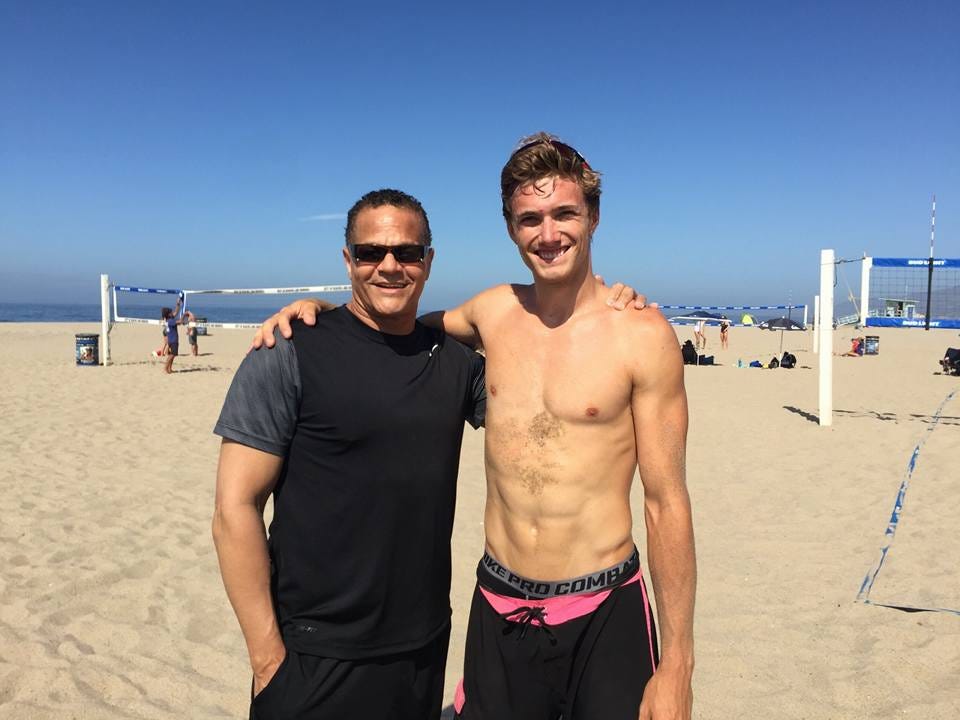 Catching up with my Uncle when I was 22—still getting valuable sand reps
Catching up with my Uncle when I was 22—still getting valuable sand reps
More Volleyball Touches and Jumps
After high school when I was 18, I took a gap year. In that year I continued to grow, coached junior teams in my area, got stronger, and played any chance I got.
By the time I was 19 at Princeton, I was working my butt off in the weight room to get stronger, and would attend a yoga class a few times a month. And I was still getting a lot of jumping reps on the court. Attacking, blocking, and serving in a specific, game-like way.
As an opposite for four years at Princeton I got to max jump on a lot of high ball attacks and serves, and especially back row balls. Today my favorite play is still the back-row attack, pipe or D, because of the feeling of launching yourself and then flying towards the net to hammer the ball.
When you’re getting all these reps it takes a big toll on your body and joints. You need time not only for your muscles, but also for your connective tissues to adapt to the loads they are experiencing. This requires years of working really hard, and then resting. Both in the space of a given day and week, but also over months and years.
There’s the jump force you need to exert into the ground quickly to jump high but then also the massive LANDING force on your ankles, knees, hips, and low back when you land. I learned one summer with USA Volleyball that elite jumpers are landing with anywhere from 8-14x their body weight in forces. Eccentric work here–especially on one leg– can drop these forces significantly and the total amount of stress that your body experiences during a practice or game. This can be done by simply as landing softly as you can on one or two feet off of a raised box—or a rock. Land as “quietly” and absorb as much of the landing force as you can.
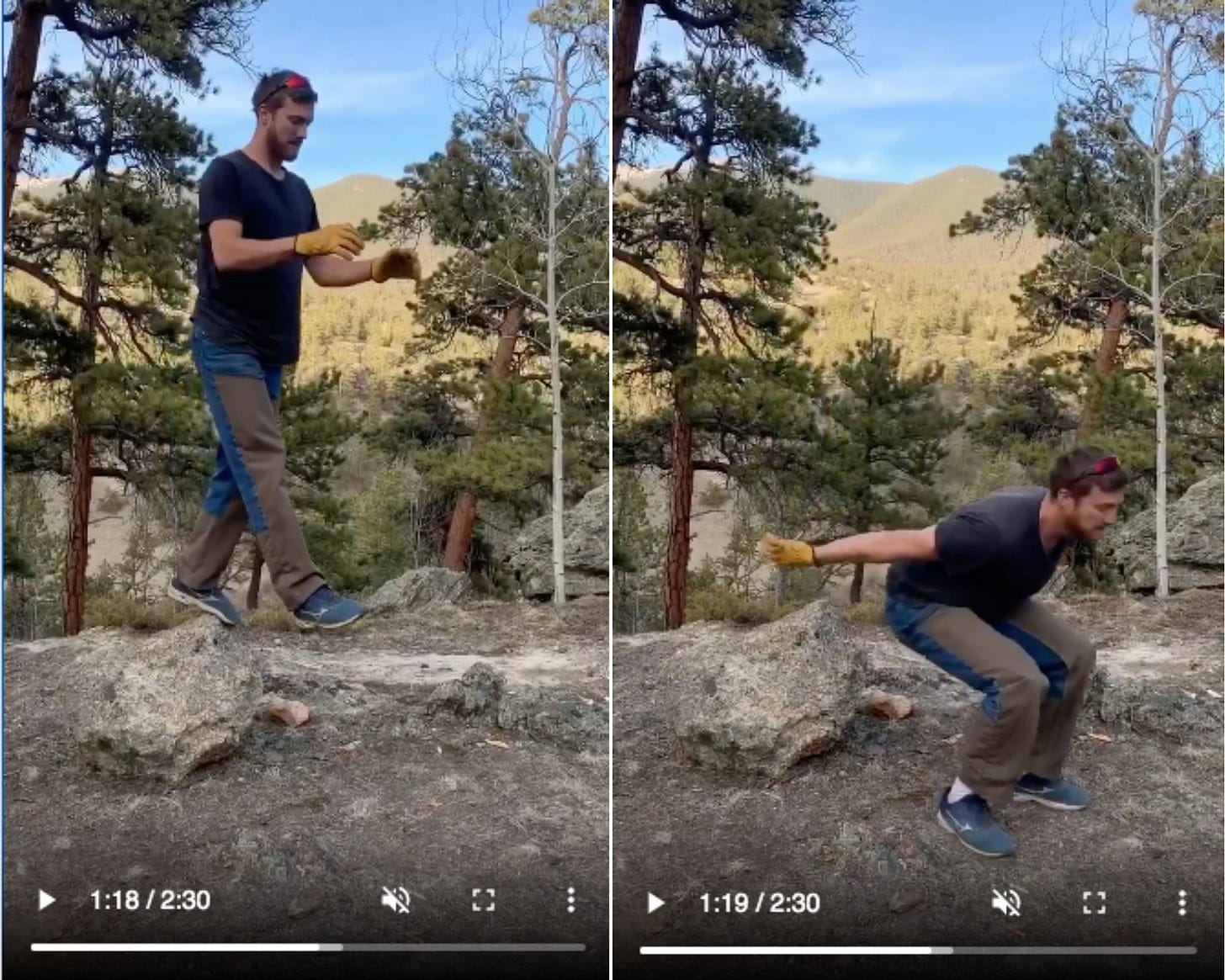 In the forest at my outdoor gym built during the first COVID wave
In the forest at my outdoor gym built during the first COVID wave
Jumping and Competing
During summers while I was studying at Princeton, from age 19-23, while many of my friends were getting internships that would later land them investment banking and consulting jobs, I was grinding away in the sand and in the weight room, becoming the strong, flexible, and competitive BEAST that I am today.
I am pictured below at age 23 in the summer of 2014, becoming the youngest player (and team) to ever to win the Motherlode in Aspen, Colorado.
Those photos are also the result of many summers of work and training with my partner Skylar del Sol and others. We organized our lives and lived like professionals before we ever made any money.
True success never comes before lots of hard work.
Genes
Genetics and natural build of course play a big role in this equation. My dad and mom were both great athletes and jumpers. I ended up with a lot of fast-twitch muscle fibers available to me. If you do everything I did, and don’t have my 6’5” (197cm) limb levers, you may never get results like mine: my best I have touched is 11’11.5” for a 41” vertical (365cm, 105 cm jump) – though I think I crack 12’ in games sometimes ;)
I was lucky, but I still take pride in the fact that I continue to maximize what I was given.
Lifting Weights— Resistance Training
As far as the weight room goes, I urge you to seek out professional help. Quality coaching here can be one of the best investments you make in your athletic career. Or at the very least follow Functional Training principles. Make sure you are training with the proper end in mind→ maximizing your strength and longevity playing the sport you love, not necessarily just getting aesthetic gym muscles to impress at the beach that don’t serve your game. For everybody (and every BODY) this will be a little different which is why finding a great coach and/or learning on your own is such a valuable part of the journey.
Amazing Resources Collected After Seven Years as a Pro— to kick start your learning
-
James C. Radcliffe’s books and work: Functional Training for Athletes At All Levels
-
Blogs, workouts, exercises, and stretching videos on the site Jump Science
-
Reading the above articles will answer 90% of questions any of you might have :) I’m still happy to provide guidance- but it’s better if you learn it for yourself!
-
Reid Hall’s volleyball-specific programs and videos.
-
Knees Over Toes Guy and Athletic Truth Group’s Mr. Infinity– affordable and great athletic programs for jumpers! I incorporate many of these exercises to supplement my main strength lifts.
-
Bob and Brad “The Most Famous Physical Therapists on the Internet”
-
Kelly Starett’s online mobility videos (Becoming a Supple Leopard)
-
Gary Hutt’s app PB Jumps.
These are all vetted resources by me that I have read or used. Many of them are FREE or very affordable. Or worth following on social media to give you reminders.
A huge thank you to all the coaches and trainers (as well as fellow teammates) who have helped me build my body and approach year after year: Keith from Princeton, Brian Swenty, teammate Jordan Richards and Coach Nikolas Buser in Switzerland, Stefan Hübner at Lüneburg [who kept me in great form through 3 professional seasons and exposed me to Michael Boyle’s work], Tim Pelot and Aaron Brock with USA Volleyball, and most recently Timo Kirchenberger with Berlin Recycling Volleys.
Recruit and seek out great mentors and teachers. The best available to you.
There’s also no excuse to not get creative in your movement and strength training. During COVID lockdowns I built my own gym in the forest. You can even get stronger using only your own bodyweight. But, as Taylor Averill dares, “You Won’t.”
Jump Technique
There’s also two important technical aspects to speak about when it comes to jumping higher.
1. Footwork
-
right, left, right, left (for right handed spikers)
-
slow, faster, fastest (finish of the jump should be the fastest part!)
Taylor Crabb and the Mckibbin brothers have a great video on this: Footwork
And for so many speaking about height, there is never a height limitation ever stopping you from becoming an elite libero or setter.
At outside hitter Taylor Crabb — at 6’0” maybe 183cm— was the most valuable player indoors in 2013 in the entire NCAA for Long Beach, and now is one of the best beach volleyball players in the world
As the great coach Marv Dunphy says, “It’s not how tall you are, it’s how good or how great you are.”
2. Big double arm lift <— can add 3+ inches to your vertical
Here’s a photo I find really beautiful of Poland’s National Team in system with the pins all with great double-arm-lift (If you look closely Brazil’s pin blocker is also using it to perform a dynamic swing block)
Too often I see the double arm lift out to the side, or the arms not being fully extended (chicken-winging) which is taking height off your jump.
Another important side note– all the vertical in the world won’t mean much if you can’t be in the right place at the right time. It’s better to be a great volleyball player/attacker than to be a great jumper. Take dynamism, skills, and vision over “vertical” when it comes to our sport. Riley Salmon and Earvin Ngapeth are just two examples of “undersized” Olympic Gold Medalists at outside hitter who score and play with their other skills, their creativity and range in attack, and all the other intangibles they bring to a team. It’s not a jumping competition. It’s a volleyball competition.
As my dad would add, it’s also a learning competition- how much better can you get compared to everyone else in the world? And how quickly?
The Weight Room is a Tool
Remember to not fall in love with the weight room too much. Hopefully you want to become a great volleyball player, not a CrossFit or bodybuilding star.
When it comes to strength training IN SEASON, Less is Often More than Enough. There is actually no significant difference in regards to maximal strength gain from doing resistance training once a week compared with doing it two or three times a week. I’ll say it again, you can get very similar results from lifting once a week compared to 2x, 3x, or more. The extra session gets you approximately 4% more gain.
Point is– it’s better to get one quality session in, than to force two or three sessions that drain you. You don’t want to make a habit of it if you’re after absolute peak performance, just something to keep in mind that has served my journey well. Don’t believe me or disagree- please Do Your Own Research (DYOR) and reach out to tell me I’m wrong!
Closing Thoughts
Finally I would add that huge gains can come from improving your nutrition and sleep habits– especially if you are embarking on some kind of weight plan and playing a lot of volleyball, too. The better you rest and recover, the better your body can adapt and grow from all the training stimulus it is experiencing. Great sleep also allows for more intense and beneficial work sessions the next day. It is the number one performance enhancing “drug” available to us all. Sleep and nutrition are topics for further write-ups, but they are a key part of the process.
This post also took a lot of work. It comes from many years of experience, hard work, failing, injuries, knowledge and learning.
Struggling to find your groove as an outside hitter? Or are you looking to add to your game and make a big push in the upcoming months? Fill out this 3 minute questionnaire and see if you're ready to work with Cody 1v1.



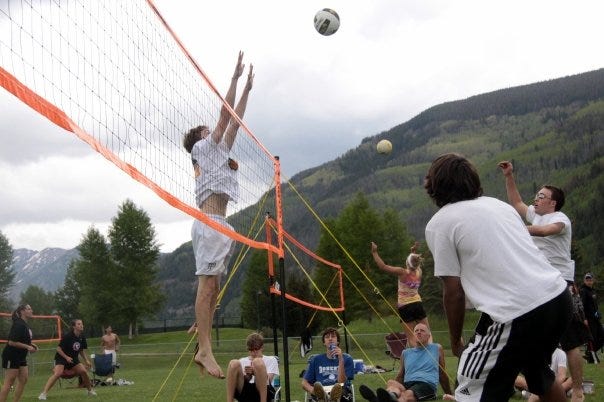
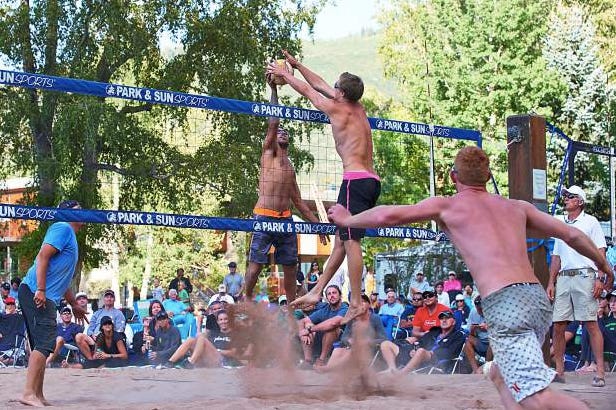
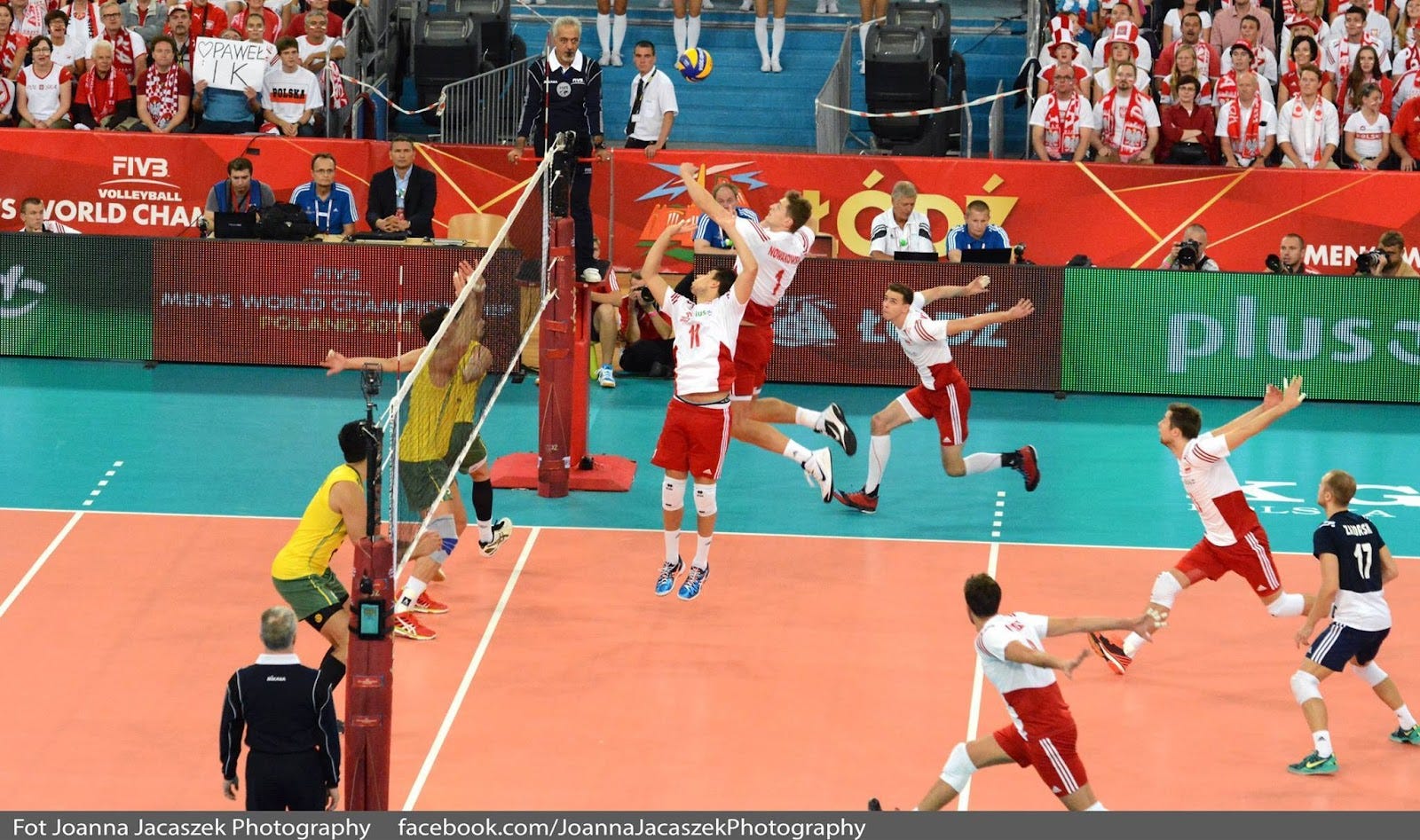
This is one of the most comprehensive and intuitive articles I have ever seen. Cody, you are amazing. Thanks for the tips. I can’t wait to get home and teach my son.